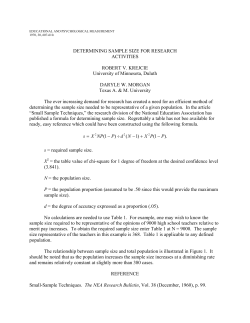
Chi square test of Froot Loops
Using Chi-Square Statistical Analysis: practice with Froot Loops™ A chi-square is a statistical tool that helps us to decide if the observed ratio is close enough to the expected ratio to be acceptable. Chi-square analysis can be used in any area, not just genetics. Whenever you have to determine if an expected ratio fits an observed ratio, you can use the chi-square. Analysis of Results The chi-square ( ) test is used as an analytical tool to test the validity of a null hypothesis, which states that there is no statistically significant difference between the observed results of your experiment and the expected results. When there is little difference between the observed results and the expected results, you obtain a very low chi-square value; your hypothesis is supported. The formula for chi-square is: where: O = observed number of individuals E= expected number of individuals Statisticians have developed chi-square tables, based upon the probabilities that a particular chi-square value will come about purely by chance. There are two "features" to consider. A. Significance Level…. Scientists like to use the level of 5% (0.05) as our significant "cut-off". Any chi-square larger than the value from the 5% on the Table indicates an experiment in which the ratios observed are so far off the ratios expected that we have to conclude that the ratios expected are wrong! B. Degrees of Freedom… In order to interpret the results of the chi-square computation, one must use a table of chi-square values. The degrees of freedom of the results of a cross is equal to the phenotypic categories minus one (df = n-1). The more "classes" (categories) the more likely that a statistical "blip" will increase the acceptable limits of the chi-square. Table 1: CHI-SQUARE DISTRIBUTION TABLE Accept Hypothesis Reject Hypothesis Probability (p) Degrees of Freedom 1 2 3 4 5 6 7 8 9 10 0.95 0.004 0.10 0.35 0.71 1.14 1.63 2.17 2.73 3.32 3.94 0.90 0.80 0.70 0.50 0.02 0.21 0.58 1.06 1.61 2.20 2.83 3.49 4.17 4.86 0.06 0.45 1.01 1.65 2.34 3.07 3.82 4.59 5.38 6.18 0.15 0.71 1.42 2.20 3.00 3.83 4.67 5.53 6.39 7.27 0.30 0.20 0.46 1.07 1.64 1.39 2.41 3.22 2.37 3.66 4.64 3.36 4.88 5.99 4.35 6.06 7.29 5.35 7.23 8.56 6.35 8.38 9.80 7.34 9.52 11.03 8.34 10.66 12.24 9.34 11.78 13.44 0.10 0.05 0.01 0.001 2.71 4.60 6.25 7.78 9.24 10.64 12.02 13.36 14.68 15.99 3.84 5.99 7.82 9.49 11.07 12.59 14.07 15.51 16.92 18.31 6.64 9.21 11.34 13.38 15.09 16.81 18.48 20.09 21.67 23.21 10.83 13.82 16.27 18.47 20.52 22.46 24.32 26.12 27.88 29.59 Problem: Null hypothesis: Worksheet: Classes (colors) Observed # Expected # O-E (O-E) 2 total 2 (O-E) /E Sum = X2 = _________ • How many degrees of freedom do you use for these data? ___________ • What is the “critical value” for a p of 0.05? ___________ • Is your x2 value greater or less than this value? GREATER / LESS • Do you accept or reject the null hypothesis based on this? Circle one: ACCEPT / REJECT • Is there a statistically significant difference between the number of different colors in your container of cereal? YES / NO
© Copyright 2025









